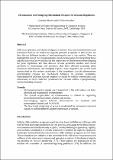Chromosome Intermingling: Mechanical Hotspots for Genome Regulation
Author(s)
Uhler, Caroline; Shivashankar, G.V.
DownloadTCB_revised_final-June18-2017_clean.pdf (831.1Kb)
Publisher with Creative Commons License
Publisher with Creative Commons License
Creative Commons Attribution
Terms of use
Metadata
Show full item recordAbstract
Cells sense physical and chemical signals from their local microenvironment and transduce them to the nucleus to regulate genomic programs. In this review, we first discuss different modes of mechanotransduction to the nucleus. Then we highlight the role of the spatial organization of chromosomes for integrating these signals. In particular, we emphasize the importance of chromosome intermingling for gene regulation. We also discuss various geometric models and recent advances in microscopy and genomics that have allowed accessing these nanoscale chromosome intermingling regions. Taken together, the recent work summarized in this review culminates in the hypothesis that the chromosome intermingling regions are mechanical hotspots for genome regulation. Maintenance of such mechanical hotspots is crucial for cellular homeostasis, and alterations in them could be precursors for various cellular reprogramming events including diseases.
Date issued
2017-11Department
Massachusetts Institute of Technology. Department of Electrical Engineering and Computer Science; Massachusetts Institute of Technology. Institute for Data, Systems, and SocietyJournal
Trends in Cell Biology
Publisher
Elsevier BV
Citation
Uhler, Caroline and G.V. Shivashankar. "Chromosome Intermingling: Mechanical Hotspots for Genome Regulation." Trends in Cell Biology 27, 11 (November 2017): P810-819. © 2017 Elsevier Ltd
Version: Author's final manuscript
ISSN
0962-8924